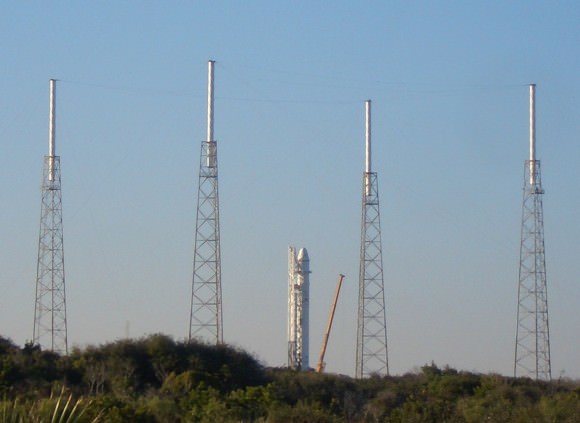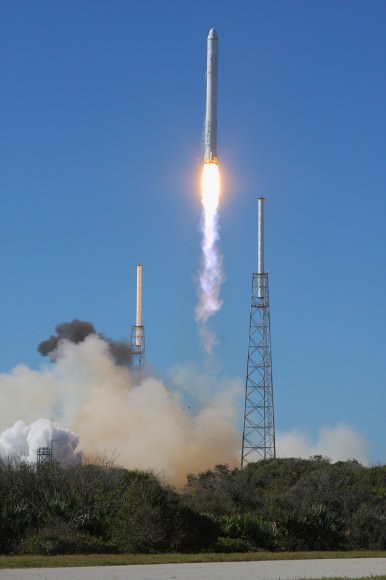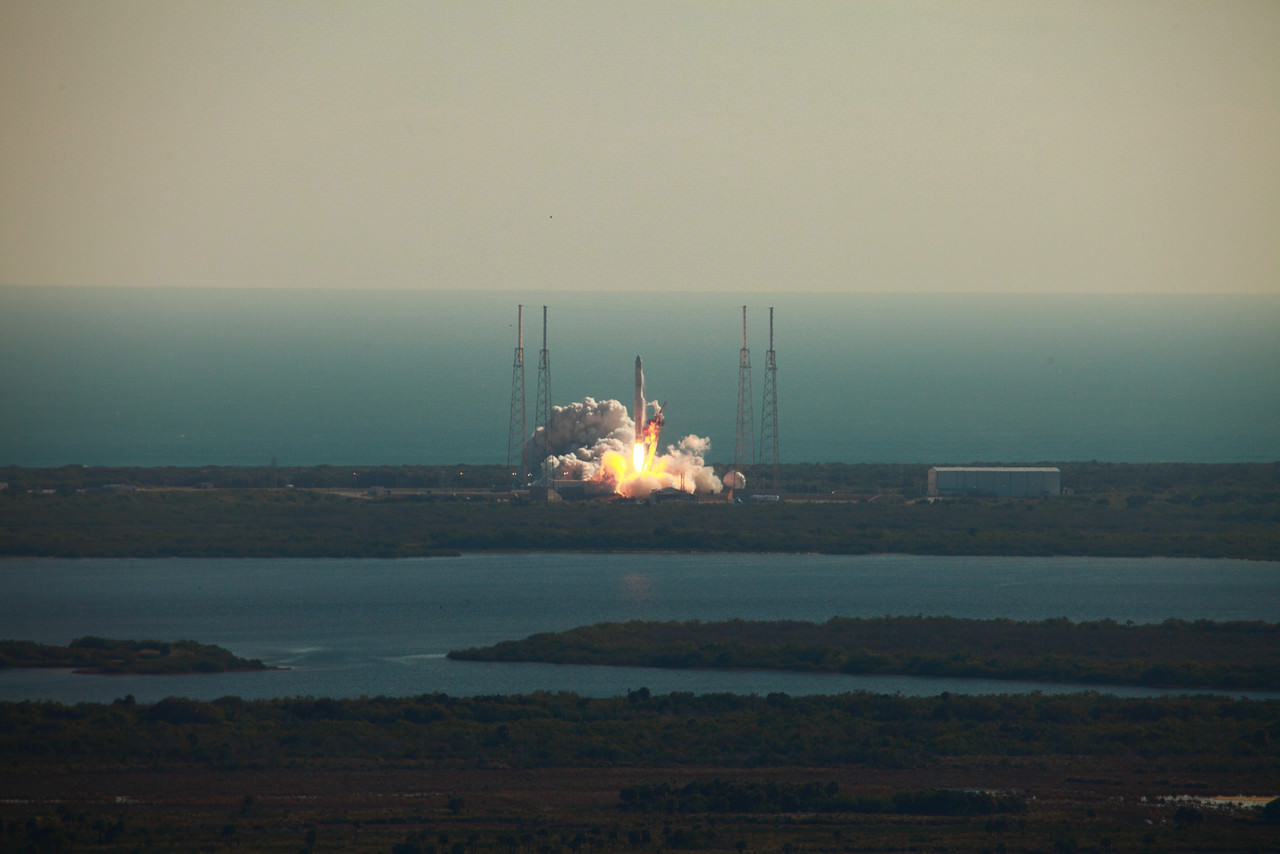[/caption]
With the success of the first and second launches of the Falcon 9 rocket as well as the successful recovery of the Dragon spacecraft, Space Exploration Technologies (SpaceX) has stated its intent to accelerate the pace of the Commercial Orbital Transportation Services (COTS) program that the private space firm has with NASA. The company has been inspecting various elements of the Dragon spacecraft that launched to orbit on Dec. 8, to make potential changes to the next Dragon – in preparation for its flight.
The company became the first private organization in history to launch a vehicle into orbit and then have it successfully return safely to Earth. The company has, for some time, been working to step up the pace of the COTS program. Under this program the first three flights of the Dragon would be demonstration flights with the third, and final demonstration flight docking with the International Space Station (ISS).

SpaceX is, if anything, a young and restless company, a company on the move and as such they want to combine the mission requirements of the second and third flights – into one. In short, SpaceX is hoping to send their next Dragon – to the space station itself, cutting out one demonstration flight in the process. However, while officials at SpaceX and the company’s CEO and CTO Elon Musk are attempting to relive the golden age of manned spaceflight (this effort is somewhat similar to the accelerated launch of the Apollo 8 mission) – NASA appears uncertain about speeding up the process. NASA has stated that if all went well with the first flight of the Dragon that it would consider speeding up the program.
The next flight of the Dragon spacecraft could take place as soon as the middle of next year. According to Musk, there are few differences between the maneuvers that Dragon conducted on Orbit this past Wednesday – and those that would be required if the craft were to rendezvous with the ISS. For a mission to the orbiting outpost, the Dragon would need to be equipped with solar arrays and certain equipment on board the craft would need to be upgraded.
To date, NASA has only stated that it is assessing the possibility of accelerating the program and that it recognizes the successes that SpaceX has enjoyed. Those within the space community note that NASA has a risk-averse philosophy and that the agency will likely want to see the company complete the requirements of the initial contract and fully demonstrate the Dragon’s capabilities.



It would be great to be able to speed up the process, but to a certain extent I would understand any NASA reluctance and their risk-adverse position. They have learnt lessons from Challenger and Columbia, and these lessons were hard-won. Both inquiries found very serious shortcomings in NASA’s attitude to safety.
SpaceX simply cannot afford to have any sort of launch failure if they are to provide a man-rated launch vehicle. I would think that they would want to have a good number of launches under their belt to truly test out their launch and reentry vehicles before sending up manned flights, because if they kill somebody, the entire COTS program will go down the gurgler, and it may take NASA’s manned program down with it. SpaceX seem to have a meticulous approach to their launches and an exemplary approach to safety, but this is just not the sort of thing that can be rushed.
Astrofiend –
“SpaceX simply cannot afford to have any sort of launch failure if they are to provide a man-rated launch vehicle. I would think that they would want to have a good number of launches under their belt to truly test out their launch and reentry vehicles before sending up manned flights, …..”
You’re misunderstanding what’s being said. SpaceX wants to go to ISS UNMANNED sooner than the agreement with NASA, negotiated years ago before anything flew, would indicate. We’re not talking manned here in the next 12 months (or for the next few years), ok?
Also, realize that almost all the commercial crew-related designs submitted by companies yesterday (again, none of them to fly for several years), will probably be inherently safer in some ways than the space shuttle. Elon pointed out during last week’s news conference, for example, that his Dragon heatshield (which was invented by NASA) is a more-capable design the NASA Orion program’s heat shield. And each of the likely manned submissions that will make the various ‘cuts’ over the next several years, are likely to have better escape options during by launch, and entry, than the space shuttle has. And I say that as someone who was a proud space shuttle team member for 15 years. But shuttle’s basic design was frozen in 1975. We need to get with the 21st century.
Dave Huntsman
Bay Village, Ohio
my personal opinion only
That’s too juicy for someone totally outside of the space tech club not to bite right into with gusto. Completely devoid of any insider intel, it’s not all all obvious that the US Gov’t gave up and froze anything about space shuttle tech.
From out here in the cheap seats events look consistent with: Money got tight as early as the Nixon years. Needs arose to be more secretive/classified than was easily done with NASA. So, DARPA, USAF etc. shifted R&D emphasis into a series of “X-vehicles” that looked like a spectacular series of pathetic dead end wastes of budget (except maybe for the X-15), until suddenly out pops the secretive mission of the X-37B and on its heels the unprecedented success of the otherwise moribund scramjet programs in the X-51.
Along the way, a number of heavy lifting shuttle launching system variations were apparently pursued and dropped. Dropped not for failure of concept or pilot program execution, but over launch payload vs cost considerations. Then too, work was done on lifting the shuttle launching system ETs into stable orbits (seemingly no biggie) and utilizing the typically left over LOX/LH2 components (NASA-CR-195281, “Utilization of the external tanks of the space transportation system”. NASA, August 23–27, 1982).
What, I ask you, is the X-37B, if not a low budget test of a scale model space shuttle of improved design, which could theoretically go full scale in a hurry as either crewed, or 100% robotic? Obviously, if full scale, then the engine thrust would have to be bumped up. But then, the basics of the launching system are already in place by continuing on with the last, best shuttle launching system, possibly hybridized with onboard auxiliary-in orbit deployable- Xenon gas fed Hall Effect plasma thrusters powered by a reactor, fuel cells or current from gallium-arsenide solar power panels.
Therefore, isn’t it entirely possible that as I type, Boeing, Lockheed Martin, and P&W Rocketdyne are putting the finishing touches on some Super Shuttle for the USAF Space Command (conveniently relieved by Global Strike Command from minding ICBMs on 12/1/09) in a vast secret facility somewhere?
Red Barron
DC Burbs
My personal opinion only
You could also claim that it is totally unfair, especially from a market POV: neither Soyuz, Shuttle, Progress, ATV or HTV had to make these “demonstrations” IIRC. (Granted, Progress was developed and tested on MIRs.)
I guess NASA pays a sum whether the demonstrations happens or not, so it is mainly SpaceX that has to gain. And this is why NASA is *not* on the move so much – they gladly pay to slow things down and get lower ROI.
Feh!Sad.Well… I can see NASA’s point of view. If they speed up the program and the first Dragon that tries to dock bashes into the station and damages a port, they’re going to look like morons. If they let the program play out and the same event occurs, they can simply state that spaceflight is difficult, and setbacks are to be expected.
So from NASA’s point of view they have a lot to lose by speeding up the program, and only a little bit to gain (deliveries would start a few months earlier).
Article author: hyphens are not – something that you just – drop in the middle of a – sentence because you – think that they look – cool.
Well demo 2 says come to within 10 km and then back away.
If all goes well at 10 km, why not proceed with demo 3 (docking?)
This is not risk mitigation, this is being afraid of the boogyman, and some CYA.